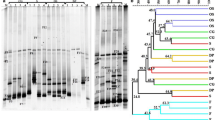Abstract
Herbaceous plants endemic to native Kenyan grassland on the Marula Estate were assessed for their phylloplane fungal occurrence using leaf cultures on tap water agar. From 26 sampled plants, 261 fungal isolates representative of 58 genera and 92 taxa were identified. The principal filamentous fungi were of the genera: Alternaria, Bipolaris, Curvularia, Epicoccum, Fusarium, Nigrospora, Periconia, Phoma and Pithomyces. The fungal species that occurred most frequently were: Alternaria alternata aggreate (73%), Pithomyces chartarum (73%) Nigrospora sphaerica (42%), Torula herbarum (30%) and Microsphaeropsis olivacea (27%). Fungi of limited occurrence were: Didymosphaeria oblitescens, Doliomyces mysoriensis, Endophragmiella dimorphospora, Parapericonia angusii, Podospora minicaudata, Spegazzinia tessarthra, Sporormiella minima, Stagonospora vitensis, Stigmella effigurata and Truncatella conorum-piceae. It is postulated that the phylloplane of these endemic plants provides a niche for endemic fungi.
Similar content being viewed by others
References
Last FT, Deighton FC. The non-parasitic microflora on the surfaces of living leaves. Trans Br Mycol Soc 1965; 48: 83–99.
Hyde KD, Hawksworth DL. Measuring and monitoring the biodiversity of microfungi. In: Hyde KD, ed. Biodiversity of tropical microfungi. Hong Kong University Press 1997: 11–28.
Hawksworth DL, Minter DW, Kinsey G, Cannon PF. Inventorying a tropical fungal biota: intensive and extensive approaches. In: Janardhanan KK, Rajendran C, Natacajan K, Hawksworth DL, eds. Tropical mycology. New Delhi: Oxford & IBH Publishing, 1996.
Hawksworth DL. The tropical fungal biota: census, pertinence, prophylaxis and prognosis. In: Isaac S, Frankland JC, Watling R, Walley AJS, eds. Aspects of tropical mycology, Cambridge University Press, 1992: 266–293.
Doidge EM. The South African fungi and lichens to the end of 1945. Bothalia 1950; 5: 1–1094.
Nattrass RM. Host lists of Kenya fungi and bacteria. Mycological Papers 1961; 81: 1–46.
Mibey RK, Hawksworth DL. Meliolaceae and Asterinaceae of the Shimba Hills, Kenya. Mycological Papers 1997; 174: 1–108.
Ibrahim KM, Kabuye CHS. An illustrated manual of Kenya grasses. FAO, Rome 1988; 1–765.
Agnew ADQ, Agnew S. Upland Kenya wild flowers. 2nd edn. East Afr Nat Hist Soc 1994; 1–374.
Ellis MB. Dematiaceous Hyphomycetes. UK Commonwealth Mycological Institute. Kew, 1971.
Ellis MB. More Dematiaceous Hyphomycetes. UK Commonwealth Mycological Institute. Kew, 1976. 169
Sutton BC. The Coelomycetes: Fungi imperfecti with picnidia, acervuli and stromata. Commonwealth Mycological Institute. Kew, 1980.
Domsch KH, Gams W, Anderson TH. Compendium of soil fungi, 1980, Vol. 1. London: Academic Press.
Sivanesan A. The Bitunicate Ascomycetes and their anamorphs. Vaduz: Cramer, 1984.
Sivanesan A. Graminicolous species of Bipolaris, Curvularia, Drechslera and Exserohilum and their teleomorphs. Mycological Papers 1987; 158: 1–261.
Pugh GJF, Buckley NG. The leaf surface as a substrate for colonization by fungi. In: Preece TF, Dickinson CH, eds. Ecology of leaf surface microorganisms. London: Academic Press, 1971: 431–446.
Diem HG. Effect of low humidity on the survival of germinated spores commonly found in the phyllosphere. In: Preece TF, Dickinson CH, eds. Ecology of leaf surface microorganisms. London: Academic Press, 1971: 209–219.
Hudson HJ. Succession of microfungi on ageing leaves of Saccharum officinarum. Trans Br Mycol Soc 1962; 45: 395–423.
Hudson HJ. The ecology of fungi on plant remains above the soil. New Phytol 1968; 67: 837–874.
Dickinson CH. Fungi on the aerial surfaces of higher plants. In: Preece TF, Dickinson CH, eds.Microbiology of aerial plant surfaces. New York: Academic Press, 1976: 291–324.
Pugh GJF, Buckley NG. Aureobasidium pullulans: an endophyte in sycamore and other trees. Trans Br Mycol Soc 1971: 57: 227–231.
Carroll GC, Carroll FE. Studies on the incidence of coniferous needle endophytes in the Pacific Northwest. Can J Bot 1978; 56: 3034–3043.
Petrini O, Müller E, Luginbühl M. Pilze als Endophyten von grunen Pflanzen. Naturwissen-schaften 1979; 66: 262–263.
Dickinson CH. Leaf surface microorganisms as pathogen antagonists and as minor pathogens. In: Jenkyn JF, Plumb RT, eds. Strategies for the control of cereal disease. Oxford: Blackwell, 1981: 109–121.
Gregory PH. Microbiology of the atmosphere 2nd edn. Aylesbury, UK: Leonard Hill Books, 1973: 1–377.
Dransfield M. The fungal air-spora at Samaru, Northern Nigeria. Trans Br Mycol Soc 1966; 49: 121–132.
Meredith DS. Atmospheric content of Nigrospora spores in Jamaican banana plantations. J Gen Microbiol 1961; 26: 343–349.
Roux C. Leptosphaerulina chartarum sp. nov., the teleomorph of Pithomyces chartarum. Trans Br Mycol Soc 1986; 86: 319–323.
Sutton BC, Gibson IAS. Pithomyces chartarum. CMI descriptions of pathogenic fungi and bacteria. N. 540. CAM International, Wallingford, UK 1977.
Marasas WFO, Schumann IH. The genus Pithomyces in South Africa. Bothalia 1972; 10: 509–516.
Marasas WFO, Adelaar TF, Kellerman TS, Minne JA, Van Rensburg IBJ, Burroughs GW. First report of facial eczema in sheep in South Africa. Onderstepoort J Vet Res 1972; 39: 107–112.
Mortimer PH, Taylor A. The experimental intoxication of sheep with sporidesmin, a metabolic product of Pithomyces chartarum. Res Vet Sci 1962; 3: 147–160.
Collin RG, Odriazola E, Towers NR. Sporidesmin production by Pithomyces chartarum isolated from Australia, Brazil, New Zealand and Uruguay. Mycol Res 1998; 102: 163–166.
Kidder RW, Beardsley DW, Erwin TC. Photosensitization in cattle grazing frosted common Bermuda grass. University of Florida Agric Exp Sta Bull 1961; 630: 1–21.
Luke HH, Wheeler ME. Toxin production by Helminthosporium victoriae. Phytopathology 1955; 45: 452–458.
Cotty PJ, Bayman P, Egel DS, Elias KS. Agriculture aflatoxins and Aspergillus. In: Powell KA, ed. The genus Aspergillus. New York: Plenum Press, 1994: 1–27.
Lockwood JL. Exploitation competition. In: Wicklow DT, Carroll GC, eds. The fungal community, its organization and role in the ecosystem. New York: Marcell Dekker, 1992: 243–263.
Wicklow DT. Interference competition. In: Wicklow DT, Carroll GC, eds. The fungal community, its organization and role in the ecosystem. New York: Marcell Dekker, 1992: 265–274
Caretta G, Piontelli E, Savino E, Bulgheroni A. Some coprophilous fungi from Kenya. Mycopathologia 1998; 142: 125–134.
Author information
Authors and Affiliations
Rights and permissions
About this article
Cite this article
Caretta, G., Piontelli, E., Picco, A.M. et al. Some Filamentous Fungi on Grassland Vegetation from Kenya. Mycopathologia 145, 155–169 (1999). https://doi.org/10.1023/A:1007038112075
Issue Date:
DOI: https://doi.org/10.1023/A:1007038112075




